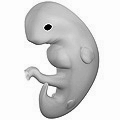
Photo from wikipedia
A 37-year-old, G3P0, with a pregnancy that arose after in vitro fertilisation, attended for nuchal translucency sonogram at 13weeks and 3 days of gestation. This scan was notable for fixed… Click to show full abstract
A 37-year-old, G3P0, with a pregnancy that arose after in vitro fertilisation, attended for nuchal translucency sonogram at 13weeks and 3 days of gestation. This scan was notable for fixed deviation and four visualised digits of the left upper extremity but otherwise normal. Chorionic villus sampling at 13weeks 6 days gestation was performed. A normal karyotype was identified. Microarray was unremarkable. The entire exome was sequenced with ExomeReveal using chorionic villi. A pathogenic nonsense TBX5 variant on chromosome 12q, which is associated with Holt-Oram Syndrome, was identified. The pregnancy was terminated approximately 15weeks of gestation. The patient’s obstetric history included miscarriage at six weeks of gestation followed by a pregnancy that required in vitro fertilisation due to subfertility. This second pregnancy at age 35 years was remarkable for an abnormal sonogram at 13weeks 6 days, in which bilateral absence of the radial and carpal bones and bilateral deviation of the wrists was noted (Figure 1(A,B)). She underwent a termination of pregnancy. The foetal DNA was banked but not analysed. An amniotic fluid cell microarray and chromosome analysis were normal. Initially, the patient and her partner, who are not phenotypically affected with signs of Holt-Oram Syndrome, underwent genetic testing and were found not to carry the pathogenic variant. This suggested that the variant is either due to gonadal mosaicism or arose de novo. High throughput sequencing was performed on blood and revealed that the patient’s partner had low level mosaicism for the p.S196X variant in the TBX5 gene. The partner underwent hand and wrist X-rays that were normal and had a normal echocardiogram. Targeted testing was then retrospectively performed on the TBX5 Gene (Exon 7 sequencing) from the banked foetal DNA from the second pregnancy. The foetus was heterozygous for the p.S196X variant in the TBX5 gene. This mutation was identical to the one noted in the chorionic villi in the third pregnancy. There was no evidence of mosaicism in either of these two samples. Discussion
Journal Title: Journal of Obstetrics and Gynaecology
Year Published: 2021
Link to full text (if available)
Share on Social Media: Sign Up to like & get
recommendations!